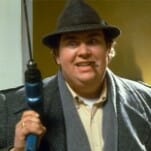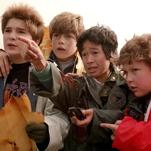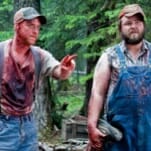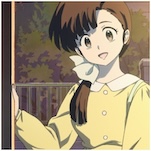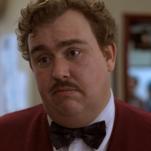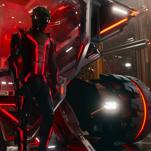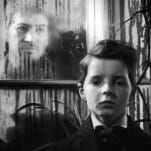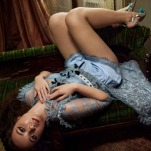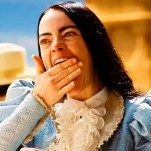The Writers Behind DC/Young Animal: Milk Wars Reflect on the Weird, Dairy-Filled Crossover “Un-Event”
Main Art by Frank Quitely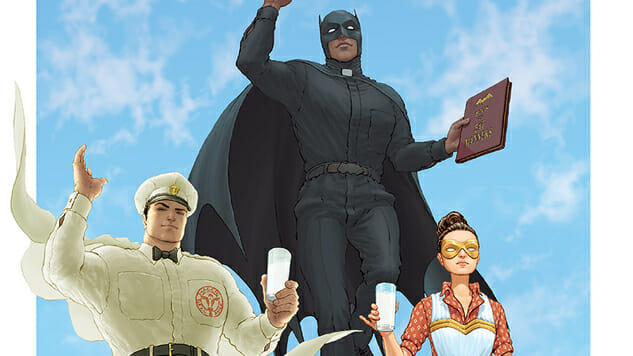
 Gerard Way’s Young Animal pop-up imprint was a breath of fresh air at DC Comics when it launched in 2016, capturing the vital transgressive spirit of early Vertigo books with a huge dose of the new—and the weird. The imprint’s initial four ongoing series each seemed to exist in their own bizarre world, which made the idea of a crossover—and with the Justice League of America, no less—a bold, unlikely, potentially disastrous step for the line. Thankfully, the heroes of the DC Universe met the Doom Patrol, Shade, Mother Panic and Cave Carson on Young Animal’s turf, resulting in a gloriously weird five-issue “un-event” centered on milk that homogenizes the publisher’s icons into ‘50s-era stereotypes of repression: Batman serves as a priest, Wonder Woman is more of a wonder wife and Milkman Man…well, you’ll need to read the series to find out his deal.
Gerard Way’s Young Animal pop-up imprint was a breath of fresh air at DC Comics when it launched in 2016, capturing the vital transgressive spirit of early Vertigo books with a huge dose of the new—and the weird. The imprint’s initial four ongoing series each seemed to exist in their own bizarre world, which made the idea of a crossover—and with the Justice League of America, no less—a bold, unlikely, potentially disastrous step for the line. Thankfully, the heroes of the DC Universe met the Doom Patrol, Shade, Mother Panic and Cave Carson on Young Animal’s turf, resulting in a gloriously weird five-issue “un-event” centered on milk that homogenizes the publisher’s icons into ‘50s-era stereotypes of repression: Batman serves as a priest, Wonder Woman is more of a wonder wife and Milkman Man…well, you’ll need to read the series to find out his deal.
With the five-issue run collected in trade paperback this month, Paste caught up with Young Animal’s three ongoing writers—Shade’s Cecil Castellucci, Mother Panic’s Jody Houser and Cave Carson’s Jon Rivera—to look back on their one-shot contributions to the Milk Wars saga. We also snagged a lactose-filled quote from former Justice League of America writer Steve Orlando, who scripted the two bookending issues and masterminded “Milk Wars” alongside Gerard Way.
“Milk Wars” is everything comics should be: bold, thought-provoking, unflinching and born from the minds of an incredible group of true creatives, through a true collaboration, that I was lucky to be part of,” Orlando said. “The comics I read as a kid bore their way into my brain like a parasite, and it’s my sincere hope “Milk Wars” does the same for a new generation, culturing new bacterial ideas in everyone it touches.”

DC/Young Animal: Milk Wars Interior Art by ACO, Tamra Bonvillain & Marissa Louise
![]()

DC/Young Animal: Milk Wars Interior Art by Mirka Andolfo & Marissa Louise
Paste: Loma is divided into different emotional states when this special begins. Why did you choose to go with Happy for the viewpoint perspective? And how does that division help Shade grow from Changing Girl to Changing Woman?
Cecil Castellucci: It could have been any feeling, but I went with Happy because I figured that Happy would notice when they weren’t happy. There’s such a lightness to happiness and a gravity to other feelings and I felt that slight shift would get noticed more quickly. As for the division of emotions causing growth, I feel that when we mature, we begin to examine our feelings more closely. We are more able to take a look at where we are and what we are feeling and maybe even why. We become familiar with surprising shifts in our emotional state. When we are young, a lot of feelings are very raw. They are very heightened because it is the first time we are feeling things so we feel it intensely. I think the division helps Shade to sort out moving from feeling it all at once to figuring out what feelings mean.
Paste: Loma’s view of gender comes from a different context than Diana’s, which is itself pretty different than the average human woman’s. How much of Wonder Wife’s ‘50s-style Happy Homemaker personality clicked with Loma as archaic and how much of it just boiled down to Loma sensing Diana wasn’t happy in that role?
Castellucci: In a way, that archaic gender view is what Loma knows. Loma was obsessed with a 1950s TV show called Life with Honey which was a housewife who lived with a scientist at Los Alamos. So that perspective was her first introduction to Earth. But once Loma arrived here she noticed that Earth was not like what she thought it was. Or that Earth had moved on from that view. I think that Loma realized that something was wrong in her first and then kind of awakens to the world not being as she knew it when she arrived. Then seeing the cracks kind of shakes it all loose. ?
Paste: Mirka Andolfo was an inspired choice for a one-shot about a very repressed version of Wonder Woman, especially with Andolfo’s much more explicit series Unnatural coming out from Image Comics soon. What did she bring to the look and feel of this special?
-

-

-

-

-

-

-

-

-

-

-

-

-

-

-

-

-

-

-

-

-

-

-

-

-

-

-

-

-

-

-

-

-

-

-

-

-

-

-

-



































